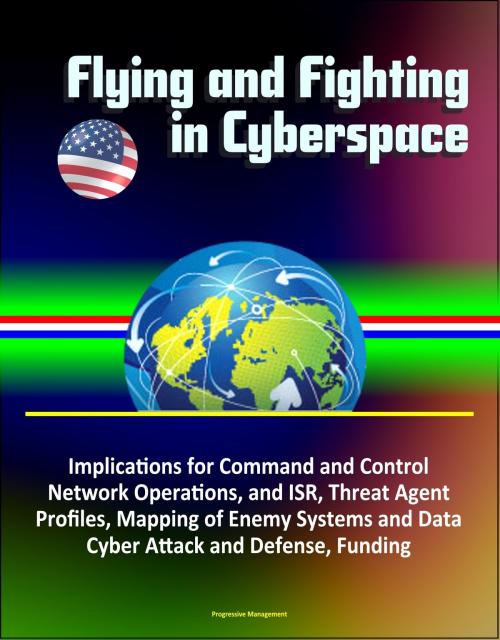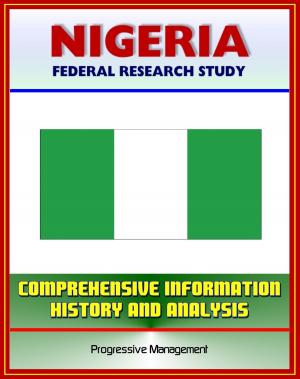Flying and Fighting in Cyberspace: Implications for Command and Control, Network Operations, and ISR, Threat Agent Profiles, Mapping of Enemy Systems and Data, Cyber Attack and Defense, Funding
Nonfiction, Computers, Networking & Communications, Computer Security, Operating Systems, History, Military, United States| Author: | Progressive Management | ISBN: | 9781310702792 |
| Publisher: | Progressive Management | Publication: | April 9, 2016 |
| Imprint: | Smashwords Edition | Language: | English |
| Author: | Progressive Management |
| ISBN: | 9781310702792 |
| Publisher: | Progressive Management |
| Publication: | April 9, 2016 |
| Imprint: | Smashwords Edition |
| Language: | English |
This excellent report has been professionally converted for accurate flowing-text e-book format reproduction. This research paper develops the foundation for a new military operating concept to "fight the net" in support of 8th Air Force requirements and stand-up as the new Cyber Command. It applies the Air Force Concept Development framework to examine cyberspace as a newly designated warfare domain, and proposes cyber capabilities and effects that the Air Force should develop and apply as it seeks to execute its mission in cyberspace. Before the Air Force can effectively lead in the cyber domain, it must first fully characterize cyber conditions, threats, and vulnerabilities, and clearly define how and where it can contribute to the national cyberspace strategy. Once the Air Force accomplishes these tasks, it can then focus on the nature of war in the cyber domain and consider the implications for military doctrine and operations. In order to successfully build capability and capacity for operating in cyberspace, the Air Force needs to institutionalize "cyber-mindedness" to underpin organizational, research and development, and human capital investments that the Air Force needs "to fly and fight" effectively in cyberspace.
THE CYBER DILEMMA * Bounding the Cyberspace Domain * Requirement for a New Framework * Physical Attributes * Domain Differentiation: Cyber versus Information Operations in Cyberspace * Broad Implications for Joint Military Operating Concepts * Effects in Cyberspace * Implications for Command and Control, Network Operations, and ISR * A New Military Problem and New Solutions * Missions that Assure Operations in Cyberspace * Time Horizon, Assumptions, and Risks * Relevance and Concluding Thoughts * THE U.S. CYBER SITUATION - THE PERFECT STORM? * Current Conditions in the Cyber Domain * Information Infrastructure and Critical Infrastructure * Existing "Weather Fronts" - Cyber Threat Agents * Threat and Threat Agent Defined * Threat Agent Profiles * Strong Tropical Disturbance Feeding Energy to the Weather Fronts a.k.a. Cyber Vulnerabilities * Battling the Simultaneously Challenging Winds of Change * U.S. National Strategic Way Ahead * National Strategy * Government Report Card * The Air Force and the Cyber Domain * THE CYBERSPACE DOMAIN OF WAR * Conduct of War in Cyberspace * The Classics * The American Way of War * Military Operational Design * The Role of Technology * Principles and Functions of War * OPERATING IN CYBERSPACE * Intrinsic Characteristics as a Unique Combat Domain * Broader Span of Effects * Surgical Precision * Stealthy/Low Probability of Detection * Non-attribution/Untraceable * Cyber Capabilities * Cyber ISR * Target System Identification and Profiling * Access and Installation of a Persistent Presence * Mapping of Enemy Systems and Data * Analyzing Adversary Capabilities * Determining Adversary Intentions * Attack/Retaliatory Strike Planning * Cyber Defense * Protection from Attack * Attack Detection and Attribution * Automated Attack Responses and Operator Alerts * Self-healing of Systems and Networks * Rapid Recovery after Attack * Cyber Attack * Cyber Attack Authorization * Disruption of Adversary C2 Systems, Processes, and Data * Denying Access to Adversary Systems and Data * Degrading Adversary System Performance * Destruction of Adversary Data, Computers, Networks * Cyberspace Effects * Cyber ISR * Cyber Defense * Cyber Attack * RECOMMENDATIONS ON THE WAY AHEAD * Methodology * Cyberspace and the Revolution in Military Affairs Debate * Revolution in Military Affairs Defined * So What? * Cyberspace Operations as a Mission Capability Package * Critical Factors * Constituting a Cyber Warfare Corps * Training for Cyber Combat * Organizing Cyber Forces * Cyber Weapon Funding * CONCLUDING THOUGHTS * BIBLIOGRAPHY
This excellent report has been professionally converted for accurate flowing-text e-book format reproduction. This research paper develops the foundation for a new military operating concept to "fight the net" in support of 8th Air Force requirements and stand-up as the new Cyber Command. It applies the Air Force Concept Development framework to examine cyberspace as a newly designated warfare domain, and proposes cyber capabilities and effects that the Air Force should develop and apply as it seeks to execute its mission in cyberspace. Before the Air Force can effectively lead in the cyber domain, it must first fully characterize cyber conditions, threats, and vulnerabilities, and clearly define how and where it can contribute to the national cyberspace strategy. Once the Air Force accomplishes these tasks, it can then focus on the nature of war in the cyber domain and consider the implications for military doctrine and operations. In order to successfully build capability and capacity for operating in cyberspace, the Air Force needs to institutionalize "cyber-mindedness" to underpin organizational, research and development, and human capital investments that the Air Force needs "to fly and fight" effectively in cyberspace.
THE CYBER DILEMMA * Bounding the Cyberspace Domain * Requirement for a New Framework * Physical Attributes * Domain Differentiation: Cyber versus Information Operations in Cyberspace * Broad Implications for Joint Military Operating Concepts * Effects in Cyberspace * Implications for Command and Control, Network Operations, and ISR * A New Military Problem and New Solutions * Missions that Assure Operations in Cyberspace * Time Horizon, Assumptions, and Risks * Relevance and Concluding Thoughts * THE U.S. CYBER SITUATION - THE PERFECT STORM? * Current Conditions in the Cyber Domain * Information Infrastructure and Critical Infrastructure * Existing "Weather Fronts" - Cyber Threat Agents * Threat and Threat Agent Defined * Threat Agent Profiles * Strong Tropical Disturbance Feeding Energy to the Weather Fronts a.k.a. Cyber Vulnerabilities * Battling the Simultaneously Challenging Winds of Change * U.S. National Strategic Way Ahead * National Strategy * Government Report Card * The Air Force and the Cyber Domain * THE CYBERSPACE DOMAIN OF WAR * Conduct of War in Cyberspace * The Classics * The American Way of War * Military Operational Design * The Role of Technology * Principles and Functions of War * OPERATING IN CYBERSPACE * Intrinsic Characteristics as a Unique Combat Domain * Broader Span of Effects * Surgical Precision * Stealthy/Low Probability of Detection * Non-attribution/Untraceable * Cyber Capabilities * Cyber ISR * Target System Identification and Profiling * Access and Installation of a Persistent Presence * Mapping of Enemy Systems and Data * Analyzing Adversary Capabilities * Determining Adversary Intentions * Attack/Retaliatory Strike Planning * Cyber Defense * Protection from Attack * Attack Detection and Attribution * Automated Attack Responses and Operator Alerts * Self-healing of Systems and Networks * Rapid Recovery after Attack * Cyber Attack * Cyber Attack Authorization * Disruption of Adversary C2 Systems, Processes, and Data * Denying Access to Adversary Systems and Data * Degrading Adversary System Performance * Destruction of Adversary Data, Computers, Networks * Cyberspace Effects * Cyber ISR * Cyber Defense * Cyber Attack * RECOMMENDATIONS ON THE WAY AHEAD * Methodology * Cyberspace and the Revolution in Military Affairs Debate * Revolution in Military Affairs Defined * So What? * Cyberspace Operations as a Mission Capability Package * Critical Factors * Constituting a Cyber Warfare Corps * Training for Cyber Combat * Organizing Cyber Forces * Cyber Weapon Funding * CONCLUDING THOUGHTS * BIBLIOGRAPHY















